The Solution to Reading Comprehension
Lessons & Units :: Harry and the Bucketful of Dinosaurs Kindergarten Unit
Read-Aloud Lesson: Harry and the Bucketful of Dinosaurs
Lesson Plan
Harry and the Bucketful of Dinosaurs

- Learning Goal
- Use evidence from the text to explain why Harry valued his toy dinosaurs so much and why he liked playing with them more than he liked videos, in order to discuss a theme of the story.
- Necessary Materials
- Provided:
- Detailed lesson plan
- Graphic organizer for guided practice
- Independent student worksheet
Not Provided:
Harry and the Bucketful of Dinosaurs
-
This lesson is a close reading of the entire text. So it’s important to engage students often, to enhance their learning. Here are two tips:
- When you ask the more complex questions from the lesson, ask students to “turn-and-talk” or “buddy-talk” before answering.
-
Once you are deep into the lesson, instead of asking students every question provided, ask them to share with you what questions they should be asking themselves at that point in the text. This is also a great opportunity to use "turn-and-talk."
- Suggested teacher language is included in the lesson.
- We recommend you read the book once to your students, either the day or morning before teaching the lesson.
- This research-based, read-aloud lesson may seem long. Why do students need the lesson to be this way?
Part 1: Teacher Modeling and Questioning
Write the following student-friendly learning goal on the board, then read the learning goal out loud with the class.
We will be able to explain why Harry likes his toy dinosaurs so much.
Read pages 1 and 2 out loud, then stop. Page 2 ends with, “...DINOSAURS!” Show students the accompanying illustrations. If possible, always show students the illustrations on the pages you read throughout the lesson.
1.
Teacher asks: Gran thinks the attic needs cleaning out. Who helps Gran clean?
Students answer: Harry helps Gran clean.
2.
Teacher asks: What does Harry find in an old box?
Students answer: Harry finds dinosaurs.
3.
Teacher says (models thinking): The story has not told us much about Harry. It has given us clues about who he is, though. I can see from the picture that he is a little boy. Also, the word “Gran” sounds like it could be short for “grandma” or “grandmother.” I see from the picture that Gran is an old woman, so I am going to guess that Harry is her grandson. See what else you can figure out about Harry as we keep reading.
Read page 3. Page 3 ends with, “...the broken ones.”
4.
Teacher asks: What does Harry do with the dinosaurs after taking them downstairs?
Students answer (elicit both responses before moving on):
- Harry unbends the bent dinosaurs.
- Harry fixes the broken dinosaurs.
Part 2: Guided Practice and Discussion
For this oral lesson, it is suggested to have the completed graphic organizer on the board with the answers concealed. After students provide a correct answer, reveal the corresponding answer on the graphic organizer.
Begin by filling in the fields of the “Where was Harry?” column of the graphic organizer.
1.
Teacher asks: What was Harry doing with the dinosaurs when he was in the attic?
Students answer (responses may vary but should resemble the following): Harry found the dinosaurs in the attic.
2.
Teacher asks: When Harry found the dinosaurs, how did he probably feel?
Students answer (responses may vary but should resemble the following): Harry probably felt excited.
3.
Teacher asks: What was Harry doing with the dinosaurs at the library?
Students answer: Harry was telling the dinosaurs their names.
Part 3: Student Independent Practice
Read each question out loud to your students and have each student complete the worksheet independently. For questions 5 A) and 6, you can have students draw their answers, answer orally, or write their answers, depending on your students’ progress. If you have them write their answers, you may want to write the word(s) on the board for them to copy.
Texts & Materials
Standards Alignment
(To see all of the ReadWorks lessons aligned to your standards, click here.)





I really like this story.